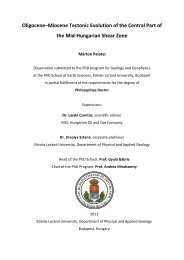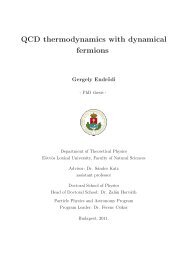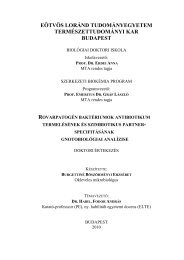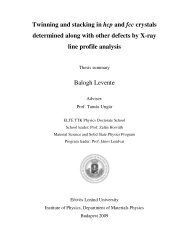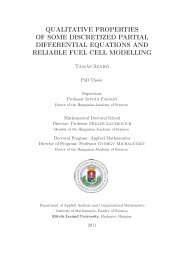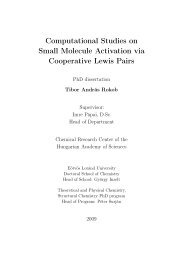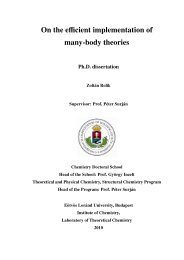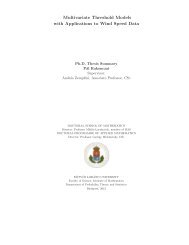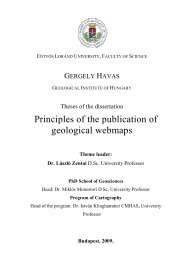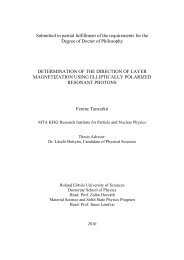Graph Polynomials and Graph Transformations in ... - ELTE TTK TEO
Graph Polynomials and Graph Transformations in ... - ELTE TTK TEO
Graph Polynomials and Graph Transformations in ... - ELTE TTK TEO
Create successful ePaper yourself
Turn your PDF publications into a flip-book with our unique Google optimized e-Paper software.
Summary of the Ph.D. dissertation<strong>Graph</strong> <strong>Polynomials</strong> <strong>and</strong> <strong>Graph</strong> <strong>Transformations</strong><strong>in</strong> Algebraic <strong>Graph</strong> TheoryPéter CsikváriEötvös Loránd University, Institute of MathematicsDoctoral School: MathematicsDirector: Miklós LaczkovichDoctoral Program: Pure MathematicsDirector: András SzűcsSupervisors: Tamás Szőnyi <strong>and</strong> András SárközyApril, 2011
1. IntroductionIn the center of the dissertation graph polynomials <strong>and</strong> graph transformations st<strong>and</strong>,their role <strong>in</strong> algebraic <strong>and</strong> extremal graph theoretic problems. The algebraic graph theoryhas a long history due to its <strong>in</strong>timate relationship with chemistry <strong>and</strong> (statistical)physics. In these fields one often describe a system, state or a molecule by an appropriateparameter. Then it rises the purely mathematical question whether what the extremalvalues of this parameter are. In the dissertation we give some general methods to attackthese k<strong>in</strong>ds of extremal problems. In the first, bigger half of the dissertation we studytwo graph transformations, the so-called Kelmans transformation <strong>and</strong> the generalized treeshift <strong>in</strong>troduced by the author. The Kelmans transformation can be applied to all graphs,while one can apply the generalized tree shift only for trees. The importance of thesetransformations lies <strong>in</strong> the fact that surpris<strong>in</strong>gly many natural graph parameters <strong>in</strong>crease(or decrease) along these transformations. This way we ga<strong>in</strong> a considerable <strong>in</strong>formationabout the extremal values of the studied parameter.In the second half of the dissertation we study a purely extremal graph theoretic problem,the so-called density Turán problem which, however, turn out to be strongly relatedto algebraic graph theory <strong>in</strong> several ways. As a by-product of the efforts we did to solvethe problem we give a solution to a longst<strong>and</strong><strong>in</strong>g open problem concern<strong>in</strong>g trees hav<strong>in</strong>gonly <strong>in</strong>teger eigenvalues.2. Notations <strong>and</strong> basic def<strong>in</strong>itionsBefore we start to survey our results, we <strong>in</strong>troduce the most important notations.We will follow the usual notation: G is a simple graph, V (G) is the set of its vertices,E(G) is the set of its edges. In general, |V (G)| = n <strong>and</strong> |E(G)| = e(G) = m. We willuse the notation N(x) for the set of the neighbors of the vertex x, |N(v i )| = deg(v i ) = d idenote the degree of the vertex v i . We will also use the notation N[v] for the closedneighborhood N(v) ∪ {v}. The complement of the graph G will be denoted by G.K n will denote the complete graph on n vertices, meanwhile K n,m the complete bipartitegraph with color classes of size n <strong>and</strong> m. Let P n <strong>and</strong> S n denote the path <strong>and</strong> the star onn vertices, respectively.Let M 1 <strong>and</strong> M 2 be two graphs with dist<strong>in</strong>guished vertices u 1 ,u 2 of M 1 <strong>and</strong> M 2 , respectively.Let M 1 : M 2 be the graph obta<strong>in</strong>ed from M 1 ,M 2 by identify<strong>in</strong>g the vertices of u 1<strong>and</strong> u 2 . So |V (M 1 : M 2 )| = |V (M 1 )| + |V (M 2 )| − 1 <strong>and</strong> E(M 1 : M 2 ) = E(M 1 ) ∪ E(M 2 ).Note that this operation depends on the vertices u 1 ,u 2 , but <strong>in</strong> general we do not <strong>in</strong>dicateit <strong>in</strong> the notation.The matrix A(G) will denote the adjacency matrix of the graph G, i.e., A(G) ij is thenumber of edges go<strong>in</strong>g between the vertices v i <strong>and</strong> v j . S<strong>in</strong>ce A(G) is symmetric, itseigenvalues are real <strong>and</strong> we will denote them by µ 1 ≥ µ 2 ≥ · · · ≥ µ n . We will also usethe notation µ(G) for the largest eigenvalue <strong>and</strong> we will call it the spectral radius of thegraph G. The characteristic polynomial of the adjacency matrix will be denoted byn∏φ(G,x) = det(xI − A(G)) = (x − µ i ).We will simply call it the adjacency polynomial.i=11
2The Laplacian matrix of G is L(G) = D(G) − A(G) where D(G) is the diagonal matrixfor which D(G) ii = d i , the degree of the vertex v i . We will denote the eigenvalues of theLaplacian matrix by λ 1 ≥ λ 2 ≥ ...λ n−1 ≥ λ n = 0. The characteristic polynomial of theLaplacian matrix will be denoted byn∏L(G,x) = det(xI − L(G)) = (x − λ i ).We will simply call it the Laplacian polynomial.We mention here that τ(G) will denote the number of spann<strong>in</strong>g trees of the graph G.Let m r (G) denote the number of r <strong>in</strong>dependent edges (i.e., the r-match<strong>in</strong>gs) <strong>in</strong> thegraph G. We def<strong>in</strong>e the match<strong>in</strong>g polynomial of G asi=1M(G,x) = ∑ r=0(−1) r m r (G)x n−2r .The roots of this polynomial are real, <strong>and</strong> we will denote the largest root by t(G).Let i k (G) denotes the number of <strong>in</strong>dependent sets of size k. The <strong>in</strong>dependence polynomialof the graph G is def<strong>in</strong>ed asI(G,x) = 1 − i 1 (G)x + i 2 (G)x 2 − i 3 (G)x 3 − ...Let β(G) denote the smallest real root of I(G,x). It exists <strong>and</strong> it satisfies the <strong>in</strong>equality0 < β(G) ≤ 1.Let ch(G,λ) be the chromatic polynomial of G; so for a positive <strong>in</strong>teger λ the valuech(G,λ) is the number of ways that G can be well-colored with λ colors. It is <strong>in</strong>deed apolynomial <strong>in</strong> λ <strong>and</strong> it can be written <strong>in</strong> the formn∑ch(G,x) = (−1) n−k c k (G)x k ,where c k (G) ≥ 0.k=13. Kelmans transformationWe def<strong>in</strong>e the Kelmans transformation as follows.Def<strong>in</strong>ition 3.1. Let u,v be two vertices of the graph G, we obta<strong>in</strong> the Kelmans transformationof G as follows: we erase all edges between v <strong>and</strong> N(v)\(N(u) ∪ {u}) <strong>and</strong> addall edges between u <strong>and</strong> N(v)\(N(u) ∪ {u}). The obta<strong>in</strong>ed graph has the same number ofedges as G; <strong>in</strong> general we will denote it by G ′ without referr<strong>in</strong>g to the vertices u <strong>and</strong> v.u v u vG G’Figure 1. The Kelmans transformation.
Kelmans studied the follow<strong>in</strong>g problem when he <strong>in</strong>troduced his transformation. LetR k q(G) be the probability that if we remove the edges of the graph G with probability q,<strong>in</strong>dependently of each other, then the obta<strong>in</strong>ed r<strong>and</strong>om graph has at most k components.Kelmans showed that the Kelmans transformation decreases this probability for every q, <strong>in</strong>other words, R k q(G ′ ) ≤ R k q(G). Satyanarayana, Schoppmann <strong>and</strong> Suffel [10] rediscoveredthis result <strong>and</strong> they proved that the Kelmans transformation decreases the number ofspann<strong>in</strong>g trees: τ(G ′ ) ≤ τ(G). We proved the follow<strong>in</strong>g results.Theorem 3.2. [1] Let G ′ be obta<strong>in</strong>ed from G by a Kelmans transformation. Let µ(G)<strong>and</strong> µ(G ′ ) denote the largest eigenvalue of the adjacency matrix of G <strong>and</strong> G ′ , respectively.Then µ(G ′ ) ≥ µ(G).This result enabled us to atta<strong>in</strong> a breakthrough <strong>in</strong> an old problem of Eva Nosal. In thisproblem one has to bound the expression µ(G) + µ(G) <strong>in</strong> terms of the number of vertices.We managed to prove the follow<strong>in</strong>g theorem which was a significant improvement of theprevious results.Theorem 3.3. [1] Let G be a graph on n vertices. Thenµ(G) + µ(G) ≤ 1 + √ 3n.2We managed to prove the follow<strong>in</strong>g theorems concern<strong>in</strong>g graph polynomials.Theorem 3.4. [5] Let M(G,x) be the match<strong>in</strong>g polynomial of the graph G:M(G,x) = ∑ r=0(−1) r m r (G)x n−2r .3Let t(G) denote the largest root of the match<strong>in</strong>g polynomial. Let G ′ be obta<strong>in</strong>ed from G bya Kelmans transformation.Then m k (G ′ ) ≤ m k (G) holds for every 1 ≤ k ≤ n/2 <strong>and</strong> t(G ′ ) ≥ t(G).Theorem 3.5. [5] Let I(G,x) be the <strong>in</strong>dependence polynomial of the graph G:I(G,x) = ∑ k=0(−1) k i k (G)x k .Let β(G) denote the smallest root of the <strong>in</strong>dependence polynomial. Let G ′ be obta<strong>in</strong>ed fromG by a Kelmans transformation.Then i k (G ′ ) ≥ i k (G) holds for every 1 ≤ k ≤ n <strong>and</strong> β(G ′ ) ≤ β(G).Theorem 3.6. [5] Let L(G,x) = ∑ nk=1 (−1)n−k a k (G)x k be the Laplacian polynomial ofthe graph G. Let G ′ be obta<strong>in</strong>ed from G by a Kelmans transformation.Then a k (G ′ ) ≤ a k (G) for 1 ≤ k ≤ n.Theorem 3.7. [5] Let ch(G,x) = ∑ nk=1 (−1)n−k c k (G)x k be the chromatic polynomial ofthe graph G. Let G ′ be obta<strong>in</strong>ed from G by a Kelmans transformation.Then c k (G ′ ) ≤ c k (G) for 1 ≤ k ≤ n.4. Generalized tree shiftWe def<strong>in</strong>e the generalized tree shift as follows.
4Def<strong>in</strong>ition 4.1. [2] Let T be a tree <strong>and</strong> let x <strong>and</strong> y be vertices such that all the <strong>in</strong>teriorpo<strong>in</strong>ts of the path xPy (if they exist) have degree 2 <strong>in</strong> T. The generalized tree shift (GTS)of T is the tree T ′ obta<strong>in</strong>ed from T as follows: let z be the neighbor of y ly<strong>in</strong>g on the pathxPy, let us erase all the edges between y <strong>and</strong> N T (y)\{z} <strong>and</strong> add the edges between x<strong>and</strong> N T (y)\{z}. We will denote the obta<strong>in</strong>ed tree by T ′ without referr<strong>in</strong>g to the role of x<strong>and</strong> y. We call the generalized tree shift proper if T <strong>and</strong> T ′ are not isomorph.1 2 . . . k−1 kxzy1x2k−1ykAB A BFigure 2. The generalized tree shift.Notations: In what follows we assume that the path xPy has exactly k vertices. The setA ⊂ V (T) consists of the vertices which can be reached with a path from k only through1, <strong>and</strong> similarly the set B ⊂ V (T) consists of those vertices which can be reached with apath from 1 only through k. Let H 1 be the tree <strong>in</strong>duced by the vertices of A ∪ {1} <strong>in</strong> T,similarly let H 2 denote the tree <strong>in</strong>duced by the vertices of B ∪ {k} <strong>in</strong> T. Note that H 1<strong>and</strong> H 2 are both subtrees of T ′ as well.This transformation determ<strong>in</strong>es a partially ordered set on the set of trees on n vertices.Def<strong>in</strong>ition 4.2. [2] Let us say that T ′ > T if T ′ can be obta<strong>in</strong>ed from T by some propergeneralized tree shift. The relation > <strong>in</strong>duces a poset on the trees on n vertices, s<strong>in</strong>ce thenumber of leaves of T ′ is greater than the number of leaves of T, more precisely the twonumbers differ by one. Hence the relation > is <strong>in</strong>deed extendable. We call this poset the<strong>in</strong>duced poset of the generalized tree shift.The follow<strong>in</strong>g observation is very simple.Theorem 4.3. [2] The m<strong>in</strong>imal element of the the <strong>in</strong>duced poset of the generalized treeshift is the path on n vertices, its maximal element is the star on n vertices.Remark 4.4. So whenever we prove that the generalized tree shift <strong>in</strong>creases a certa<strong>in</strong>parameter we immediately obta<strong>in</strong> that the maximum of this parameter is atta<strong>in</strong>ed at thestar <strong>and</strong> the m<strong>in</strong>imum of this parameter is atta<strong>in</strong>ed at the path among the trees on nvertices.In the sequel we survey some of the most important properties of the generalized treeshift.Theorem 4.5. [2, 4] Let T be a tree <strong>and</strong> let T ′ be obta<strong>in</strong>ed from T by a generalized treeshift.Then m k (T ′ ) ≤ m k (T) for 1 ≤ k ≤ n/2 . Furthermore, µ(T ′ ) ≥ µ(T) <strong>and</strong> µ(T ′ ) ≥ µ(T).
5Figure 3. The poset of trees on 6 vertices.Remark 4.6. In the case of trees the characteristic polynomial of the adjacency matrix<strong>and</strong> the match<strong>in</strong>g polynomial co<strong>in</strong>cide, <strong>in</strong> other words, φ(T,x) = M(T,x) <strong>and</strong> so t(T) =µ(T).Theorem 4.7. [4] Let L(G,x) = ∑ nk=1 (−1)n−k a k (G)x k be the Laplacian polynomial of thegraph G. Let λ 1 (G) ≥ λ 2 (G) ≥ ...λ n−1 (G) ≥ λ n (G) = 0 be the roots of L(G,x), <strong>in</strong> otherwords, the eigenvalues of the Laplacian matrix. Let T be a tree <strong>and</strong> let T ′ be obta<strong>in</strong>ed fromT by a generalized tree shift.Then a k (T ′ ) ≤ a k (T) for 1 ≤ k ≤ n, λ 1 (T ′ ) ≥ λ 1 (T) <strong>and</strong> λ n−1 (T ′ ) ≥ λ n−1 (T).Theorem 4.8. [4] Let I(G,x) be the <strong>in</strong>dependence polynomial of the graph G:I(G,x) = ∑ k=0(−1) k i k (G)x k .Let β(G) denote the smallest root of the <strong>in</strong>dependence polynomial. Let T be a tree <strong>and</strong> letT ′ be obta<strong>in</strong>ed from T by a generalized tree shift.Then i k (T ′ ) ≥ i k (T) for 1 ≤ k ≤ n <strong>and</strong> β(T ′ ) ≤ β(T).Remark 4.9. There is a common th<strong>in</strong>g <strong>in</strong> the above mentioned theorems, namely, all ofthe above mentioned graph polynomials satisfy a certa<strong>in</strong> recursion formula. As a consequenceone can factorize the expression f(T ′ ,x)−f(T,x) <strong>in</strong> a special form. One can proveall the above mentioned theorem by this factorisation together with some “monotonicity”property of the studied parameter.Lemma 4.10. [4] Assume that the graph polynomials f <strong>and</strong> g satisfy the follow<strong>in</strong>g recursion.f(M 1 : M 2 ,x) = c 1 f(M 1 ,x)f(M 2 ,x) + c 2 f(M 1 ,x)g(M 2 |u 2 ,x)++c 2 g(M 1 |u 1 ,x)f(M 2 ,x) + c 3 g(M 1 |u 1 ,x)g(M 2 |u 2 ,x),where c 1 ,c 2 ,c 3 are rational functions of x. Furthermore, assume that c 2 f(K 2 )+c 3 g(K 2 |1) ≠0. Thenf(T) − f(T ′ ) = c 4 (c 2 f(P k ) + c 3 g(P k |1))(c 2 f(H 1 ) + c 3 g(H 1 |1))(c 2 f(H 2 ) + c 3 g(H 2 |k)),
6wherec 4 =g(P 3 |1) − g(P 3 |2)(c 2 f(K 2 ) + c 3 g(K 2 |1)) 2.The orig<strong>in</strong>al application of the generalized tree shift was the follow<strong>in</strong>g theorem. (Unlikethe other theorems, this statement has a purely comb<strong>in</strong>atorial proof.)Theorem 4.11. [2] Let W k (G) denote the number of closed walks of length k. Let T be atree <strong>and</strong> let T ′ be obta<strong>in</strong>ed from T by a generalized tree shift.Then W k (T ′ ) ≥ W k (T) for every k ≥ 1.Remark 4.12. Let µ 1 ≥ µ 2 ≥ · · · ≥ µ n be the eigenvalues of the adjacency matrix of thegraph G. Thenn∑W k (G) = µ k j.Thus the follow<strong>in</strong>g theorem is an easy consequence of the previous statement.Corollary 4.13. [2] Let EE(G) = ∑ nj=1 eµ jdenote the Estrada <strong>in</strong>dex of the graph G. LetT be a tree <strong>and</strong> let T ′ be obta<strong>in</strong>ed from T by a generalized tree shift.Then EE(T ′ ) ≥ EE(T).Remark 4.14. The conjecture concern<strong>in</strong>g the Estrada <strong>in</strong>dex prompted V. Nikiforov tostate the conjecture that the m<strong>in</strong>imal value of W k (G) is atta<strong>in</strong>ed at the path on n verticesamong the trees on n vertices. The generalized trees shift was developed to attack thisconjecture.j=15. Density Turán problemThe follow<strong>in</strong>g problem was studied <strong>in</strong> Zoltán L. Nagy’s master thesis [8]. This part isbased on a jo<strong>in</strong>t work with him.Given a simple, connected graph H. Def<strong>in</strong>e the blown-up graph G[H] of H as follows.Replace all vertices v i ∈ V (H) by a cluster A i <strong>and</strong> we connect vertices between the clustersA i <strong>and</strong> A j (not necessarily all) if v i <strong>and</strong> v j were adjacent <strong>in</strong> H. Question: what k<strong>in</strong>d ofedge densities we have to require between the clusters so that G[H] surely conta<strong>in</strong>s agraph isomorph with H such that the vertex correspond<strong>in</strong>g to v ∈ V (H) is <strong>in</strong> the clustercorrespond<strong>in</strong>g to v. In what follows we call this phenomenon that H is a transversal ofG[H].In the sequel we need some technical def<strong>in</strong>itions.Def<strong>in</strong>ition 5.1. [8, 9] A weighted blown-up graph is a blown-up graph where a nonnegativeweight w(u) is assigned to each vertex u such that the total weight of each clusteris 1. The density between two clusters isd ij =∑w(u)w(v).(u,v)∈Eu∈A i ,v∈A jDef<strong>in</strong>ition 5.2. [8, 9] We def<strong>in</strong>e the critical edge density d crit (H) of the graph H asfollows. The number d crit (H) is the smallest number d for which it is true that wheneverthe edge density between any two clusters of G[H] is larger than d then H is surely atransversal of G[H].
7Figure 4. A blown-up graph of the diamond conta<strong>in</strong><strong>in</strong>g the diamond as a transversalDef<strong>in</strong>ition 5.3. [6] Let x e ’s be variables assigned to each edge of a graph. The multivariatematch<strong>in</strong>g polynomial F is def<strong>in</strong>ed as follows:F(x e ,t) = ∑ M∈M( ∏ e∈Mx e )(−t) |M| ,where the summation goes over the match<strong>in</strong>gs of the graph <strong>in</strong>clud<strong>in</strong>g the empty match<strong>in</strong>g.Now we are ready to tell out our results. First we study the case when the graph H isa tree.Theorem 5.4. [6] Let T be a tree.(a) Assume that the edge density between the clusters A i ,A j of the blown-up graph G[H]is γ ij = 1 − r ij . Assume that F T (r e ,t) > 0 for t ∈ [0, 1]. Then G[T] surely conta<strong>in</strong>s T asa transversal.(b) If for the numbers γ ij = 1 − r ij , the polynomial F T (r e ,t) has a root <strong>in</strong> the <strong>in</strong>terval[0, 1] then there exists weighted blown-up graph G[T] of the tree T such that the edge densitybetween the clusters A i ,A j is γ ij , till G[T] does not conta<strong>in</strong> T as a transversal.Corollary 5.5. [9] Let T be a tree <strong>and</strong> µ(T) be the largest eigenvalue of the adjacencymatrix of T. Thend crit (T) = 1 − 1µ(T) 2.If H is an arbitrary graph then the follow<strong>in</strong>g statements rema<strong>in</strong> true from the abovetheorems.Theorem 5.6. [6] Let H be a simple graph. Assume that the edge density between theclusters A i ,A j of the blown-up graph G[H] is γ ij = 1 − r ij . Assume that F H (r e ,t) > 0 fort ∈ [0, 1]. Then G[H] surely conta<strong>in</strong>s H as a transversal.
8Theorem 5.7. [6] Let H be a simple graph <strong>and</strong> let t(H) denote the largest root of thematch<strong>in</strong>g polynomial of H. Thend crit (H) ≤ 1 − 1t(H) 2.Corollary 5.8. [6] Let H be a simple graph with largest degree ∆. Then1 − 1 ∆ ≤ d krit(H) < 1 −14(∆ − 1) .As a lower bound we managed to prove the follow<strong>in</strong>g theorem. Before we give thestatement we need some def<strong>in</strong>itions.Def<strong>in</strong>ition 5.9. A proper label<strong>in</strong>g of the vertices of the graph H is a bijective function ffrom {1, 2,...,n} to the set of vertices such that the vertex set {f(1),...,f(k)} <strong>in</strong>ducesa connected subgraph of H for all 1 ≤ k ≤ n. The set of the proper label<strong>in</strong>gs will bedenoted by S(H).The monotone-path tree T f (H) of H is def<strong>in</strong>ed as follows. The vertices of this graph arethe paths of the form f(i 1 )f(i 2 )...f(i k ) where 1 = i 1 < i 2 < · · · < i k <strong>and</strong> two such pathsare connected if one is the extension of the other with exactly one new vertex.45131212 13 14 15123 125 134 1451234134512345Figure 5. A monotone-path tree of the wheel on 5 vertices.Theorem 5.10. [6]{ }1d crit (H) ≥ max 1 − .f∈S(H) µ(T f (H)) 2Remark 5.11. In the case of the complete bipartite graph, for arbitrary proper label<strong>in</strong>gthe largest eigenvalue of the monotone-path tree is √ m + n − 1. So the follow<strong>in</strong>gconjecture is very natural.Conjecture 5.12. [6]d crit (K n,m ) = 1 −1m + n − 1 .
6. Integral treesWe call a tree <strong>in</strong>tegral tree if all the eigenvalues of the tree are <strong>in</strong>tegers. The <strong>in</strong>tegraltrees are extremely rare, among the trees on at most 50 vertices only 28 are <strong>in</strong>tegral.Among the 2262366343746 trees on 35 vertices there is only one tree which is <strong>in</strong>tegral.In spite of this fact, there were known several <strong>in</strong>f<strong>in</strong>ite class of <strong>in</strong>tegral trees, all of themhad diameter at most 10. It was an open question for more than 30 years whether thereexists <strong>in</strong>tegral trees of arbitrarily large diameters. We managed to answer this questionaffirmatively.Theorem 6.1. [3] For every f<strong>in</strong>ite set S of positive <strong>in</strong>tegers there exists a tree whosepositive eigenvalues are exactly the elements of S. If the set S is different from the set {1}then the constructed tree will have diameter 2|S|.In the previous section we have seen that the monotone-path tree of the completebipartite graph K n,m has spectral radius √ n + m − 1. Indeed, the follow<strong>in</strong>g strongerstatement is also true.Theorem 6.2. Let f be proper label<strong>in</strong>g of the complete bipartite graph K n,m . Then all theeigenvalues of the monotone-path tree T f (K n,m ) have the form ± √ q where q is non-negative<strong>in</strong>teger.Hence to prove the above mentioned theorem all we have to prove is that one can putperfect squares under the square roots, this can be done <strong>in</strong>deed.References[1] Péter Csikvári: On a conjecture of V. Nikiforov, Discrete Mathematics 309 (2009), No. 13, pp.4522-4526[2] Péter Csikvári: On a poset of trees, Comb<strong>in</strong>atorica 30 (2010), No. 2, 125-137[3] Péter Csikvári: Integral trees of arbitrarily large diameters, Journal of Algebraic Comb<strong>in</strong>atorics 32(2010), No. 3., pp. 371-377[4] Péter Csikvári: On a poset of trees II, <strong>in</strong> preparation[5] Péter Csikvári: Applications of the Kelmans transformation, <strong>in</strong> preparation[6] Péter Csikvári <strong>and</strong> Zoltán L. Nagy: Density Turán problem, <strong>in</strong> preparation[7] A. K. Kelmans: On graphs with r<strong>and</strong>omly deleted edges, Acta. Math. Acad. Sci. Hung. 37 (1981),No. 1-3, pp. 77-88[8] Zoltán L. Nagy: Density Turán problem, Master’s thesis[9] Zoltán L. Nagy: A Multipartite Version of the Turán Problem - Density Conditions <strong>and</strong> Eigenvalues,The Electronic J. Comb<strong>in</strong>atorics, Vol 18(1), P46, (2011) 15pp[10] A. Satyanarayana, L. Schoppman <strong>and</strong> C. L. Suffel: A reliability-improv<strong>in</strong>g graph transformation withapplications to network reliability, Networks 22 (1992), No. 2, pp. 209-2169



